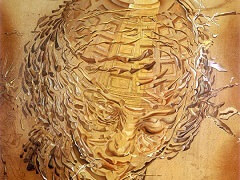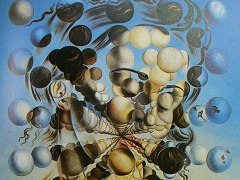Girl with Curls, 1926 by Salvador Dali

An incipient eroticism entered Dali's work in 1926, in effect positioning Girl with Curls in a class apart from the artist's previous studies of the female figure. On the one hand, Dali's academic nude of 1925 and 1926 are paragons of controlled drawing and restrained sensuality; on the other hand his close-ups of Girl's Back encourage a dialogue between the viewer and the object viewed that transforms the act of looking more into an identificatory relation proximity than an erotic exchange. In Girl with Curls, however, Dali transform a scene of earthy sexuality into a spectacle of erotic projection, as a young peasant girl standing amid the verdant green fields of the Empurda momentarily pause on her journey to gather her windswept blond curls behind her ear. As her right foot emerges from its slipper in an apparent reflex of innocent abandon, her scanty dress falls suggestively off her shoulder and drapes around her buttocks to reveal an ample pair of fleshy cheeks, thereby charging the scene with erotic energy.
The Dali later adopted the pose of the young woman to represent the surrealist/Freudian muse Gradiva in a series of drawings executed over the course of the 1930s suggests that he recognized and fully exploited the erotic appeal of the figure in Girl with Curls. Indeed, the monumental, almost phallic presence of the standing female figure is a visual topos in Dali's paintings of the 1920s and 30's.























